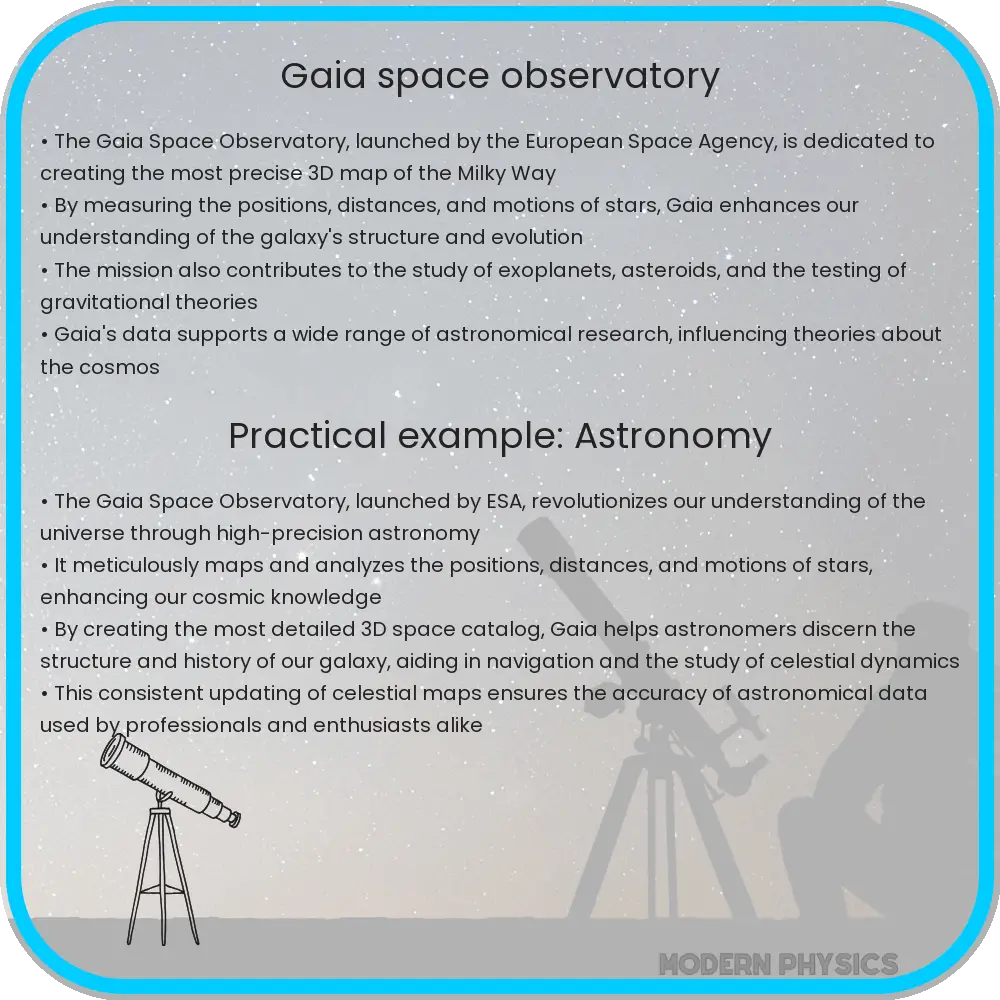Explore the Gaia Space Observatory’s mission, its impact on astrophysics, and its contributions to mapping and understanding the Milky Way in this detailed article.

Exploring the Cosmos with the Gaia Space Observatory
The Gaia Space Observatory, a cornerstone mission of the European Space Agency (ESA), has revolutionized our understanding of the Milky Way. Launched in December 2013, Gaia’s primary mission is to chart a three-dimensional map of our galaxy, providing unprecedented precision in the positions and movements of stars. Its capabilities extend beyond mere cartography; Gaia is a powerhouse for astrophysical research, offering insights into the composition, formation, and evolution of the Galaxy.
The Scientific Marvels of Gaia
At the heart of Gaia’s mission is the astrometric instrument, a feat of engineering designed to measure the positions, distances, and motions of stars with unparalleled accuracy. These measurements, known as parallaxes and proper motions, are fundamental to astrophysics, allowing scientists to infer the intrinsic luminosity, mass, and age of stars. Additionally, Gaia’s spectrophotometers collect data on the star’s spectrum, revealing its temperature, chemical composition, and radial velocity.
A New Era of Star Mapping
Gaia’s observational campaign is vast and comprehensive. Targeting over one billion stars, approximately 1% of the Milky Way’s population, Gaia provides a microscopic view of stellar neighborhoods and a macroscopic lens on galactic structures. This extensive dataset not only enhances our star maps but also informs the calibration of cosmic distance scales, impacting our understanding of the universe’s expansion.
Contributions to Astrophysics
Beyond mapping, Gaia’s data has profound implications for astrophysics. It aids in the identification of exotic stars, the study of star clusters, and the detection of asteroids within our solar system. Moreover, Gaia’s observations are crucial for testing gravitational theories and understanding the distribution of dark matter. The observatory’s findings have already led to numerous discoveries, including new celestial phenomena and refined models of galactic dynamics.
Challenges and Achievements
Despite its successes, the Gaia mission faces challenges, particularly in data processing and analysis. The sheer volume and complexity of the data require advanced algorithms and substantial computational resources. Nevertheless, the scientific community continues to unlock the potential of Gaia’s dataset, contributing to a golden age of astronomy and astrophysics.
Interdisciplinary Impact and Future Endeavors
The influence of the Gaia Space Observatory transcends traditional boundaries within the scientific community. Its contributions to astrophysics are complemented by its utility in other disciplines such as cosmology, celestial mechanics, and even galactic archaeology. By tracing the lineage and movement of stars, Gaia helps scientists reconstruct the history and evolution of the Milky Way. This “galactic archaeology” allows researchers to piece together the puzzle of our galaxy’s formation, offering clues about the cosmic processes that have shaped the universe.
Global Collaboration and Data Sharing
The success of the Gaia mission is a testament to international cooperation and the sharing of scientific data. Researchers worldwide access Gaia’s database, fostering a collaborative environment that accelerates discovery and innovation. This open-access approach ensures that the benefits of Gaia’s findings are widespread, democratizing space science and enabling a diverse range of studies and applications.
Looking to the Future
As the Gaia mission continues, the future looks bright for astronomy and space science. Plans for extended missions and updates to Gaia’s data release strategy promise to enhance the quality and depth of astrophysical research. Moreover, Gaia sets the stage for future space observatories, paving the way for more sophisticated missions that will build on its legacy. The lessons learned from Gaia’s operations, data analysis, and community engagement will undoubtedly influence the design and execution of future cosmic ventures.
Conclusion
The Gaia Space Observatory represents a monumental leap in our quest to understand the cosmos. By providing a detailed three-dimensional map of the Milky Way, Gaia not only enriches our knowledge of the galaxy but also reshapes our understanding of the universe at large. Its comprehensive dataset serves as a foundational resource for current and future generations of astronomers, enabling a myriad of scientific inquiries. As we continue to decipher the data and await new discoveries, Gaia stands as a beacon of human curiosity and ingenuity, guiding us further into the unknown depths of space.
